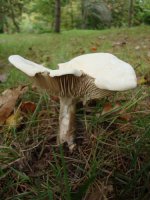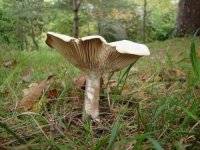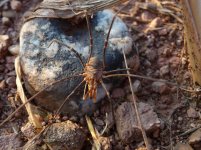Saturday 9th October
Totally failed on the snow bunting front.. Had a fungi foray scheduled for Somers, a private residence, in North Devon for the Saturday, which didn't start till 11:00, so seemed like a good opportunity for a go at the Snow Buntings that had been reported on the pager at Northam Burrows. The pager said that the birds were between the seasonal pools and the sand dunes, so I took that to be the Northern end of the burrows between the big pool and the sand dunes at the back. So I trudged around, checking out the shingly bit at the back that looked promising enough, but to no avail, found a few shaggy inckcaps, blackening waxcaps and the like, plenty of skylark, meadow pipit and finches but no Snow Buntings. On the way back I was rather surprised when two black terns flew over the burrows and Eastwards.
Onto Summers which was being led by Jeff Benn from the fungi group, who dropped us right in it by singling Nicola and I out as assistants. I decided the best thing was to cling to my fungi book and act as translator latin to English as and when required.. This site had pasture land and woodland, the latter being surprisingly dry and lacking in numbers of big mushrooms - perhaps we had reached a hiatus in the blooming season here? However there was still plenty of interest, including a couple of distinctive and destructive honey fungi and some excellent pasture fungi - many waxcaps and the cute little ringed Earthy Powdercap. Star of the fungi fauna here though is the scarce Hazel Glove's which whilst not at its best, having been slugged, was still identifiable on hazel near a stream.
After summers we headed back to Knighthayes were Nicola dragged me round to grab a few things she'd seen during the week that were new to the list, orange peel, burnt knight, shaggy pholiota. Whilst we were there we also found pink domecap and shaggy inkcap, and had a big argument about a funnel near the car park (see previous posts) which I lost - Trooping Funnel (not giant as I thought).
At this point the pager went off announcing that the snow buntings were at Northam burrows again - assuming that I'd missed them we tore back up to the site and I made the same mistake AGAIN. Heading out from the northern car park with the light starting to turn, I tried working the shingle edge, but only got so far when I found the bomb squad :eek!: turning people back from the beach! They were obviously getting ready to detonate a suspicious object on the shoreline, sure enough as I returned towards the car there was a loud and deep bang, and all the birds went up.
Later I'd find where the birds were, was well of to the West of the reserver, nowhere near where I'd looked both times...
Sites: Northam Burrows, Somers, Knighthayes
Species : Fuligo Candida (Slimemould)
Fungi: Aleria Aurantica (Orange Peel Fungus), Armillaria Gallica (Bulbous Honey Fungus), Armillaria Tabescens (Ringless Honey Fungus), Calocybe Carnea (Pink Domecap), Clavaria Fumosa (Smoky Spindles), Clitocybe Goetropa (Trooping Funnel), Coprinus comatus (Shaggy Inkcap), Cystoderma Amianthium (Earthy Powdercap), Dermoloma Cuneifolium (Crazed Cap), Enteloma Chalybeaum (Indigo Pinkgill), Enteloma Conferendum (Star Pinkgill), Hebeloma Leucosarx (a Poisonpie), Hygrocybe Persistens (Persistant Waxcap), Hygrocybe Russocriacea (Cedarwood Waxcap), Hygrocybe Virginia (Snowy Waxcap), Inocybe Geophylla (White Fibrecap), Lactarius Vietus (Grey Milkcap), Lycoperdon perlatum (Common puffball), Mycena Vitillinus (Snapping Bonnet), Pholiota Squarrosa (Shaggy Pholiota), Sclerodoma Verrucosum (Scaly Earthball), Trichloma Ustale (Burnt Knight), Hazel Glove's
Fungi 199; MLLA 95;
GT 1593
(note removed as yet unconfirmed hyxpoxylon and rosalinea species from 11th April at Park)






